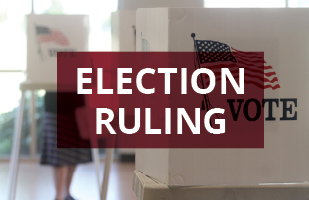Zoning Referendum Rejected Because Opponents Presented Wrong Map of Affected Area

The Court ruled that Lucas County residents will not vote on a zoning referendum because an inaccurate map of the area to be rezoned was submitted.

The Court ruled that Lucas County residents will not vote on a zoning referendum because an inaccurate map of the area to be rezoned was submitted.
Residents in a Lucas County township will not vote on a zoning referendum concerning a vehicle towing lot because an inaccurate map of the area to be rezoned was submitted, the Supreme Court of Ohio ruled today.
In a unanimous per curiam opinion, the Supreme Court found opponents of the Spencer Township rezoning did not strictly comply with a state law requiring zoning referendum proposals to be “accompanied by an appropriate map of an area affected by the zoning proposal.” The purpose of the provision is to prevent misleading people into signing petitions about the area that has been rezoned, the Court noted.
The decision affirmed a ruling by the Lucas County Board of Elections to deny placing the issue on the ballot. The board found the map circulated by the rezoning opponents depicted the nine-acre area the landowner asked the township to rezone. The township only agreed to rezone about four acres.
The zoning opponents argued the map they circulated was given to them by the township, and the map met the legal requirements. The Court today stated it is unclear whether the opponents asked the township for a map that reflected the four-acre area that was approved.
Zoning Change Contested
In October 2023, Jeff Davis applied to the Spencer Township Board of Trustees for a zoning change for nine acres. The change would allow Davis’ business to use the property for a tow lot and vehicle storage. In February 2024, the board of trustees approved a resolution to rezone a smaller portion of the property than Davis had originally requested. The resolution described the area being rezoned.
Shawn Valentine, a former Spencer Township trustee, and others circulated petitions to hold a referendum to overturn the zoning change. Under R.C. 519.12(H), the opponents must collect signatures of registered voters residing in the area equaling at least 15% of voters who voted in the last race for governor. The petition must have a map showing the area affected by the zoning proposal.
The opponents submitted petitions in March 2024 to the township trustees. The petitions went to the Lucas County Board of Elections, which determined the petitions had a valid number of signatures. The township trustees then certified the referendum petitions and requested that the board of elections place the issue on the Nov. 5 general election ballot.
Landowner Contests Ballot Issue
In July 2024, Davis filed a protest with the board of elections, making several arguments on why the issue should not be on the ballot. The board of elections agreed with Davis, focusing only on the issue of the map that accompanied the petitions. The board found it was not an “appropriate map,” as required by R.C. 519.12(H).
Valentine sought a writ of mandamus from the Supreme Court to order the board of elections to place the zoning referendum on the ballot. Because the case involves an election matter, the Supreme Court expedited the case.
Supreme Court Analyzed Referendum Requirements
The opinion noted that in a 2006 decision, the Court found that a zoning referendum petition must strictly comply with the requirement of including an appropriate map of the area affected by the zoning proposal. The Court stated a map is suitable if it does not mislead the average person about the area affected by the township’s rezoning resolution.
The Court stated that neither Valentine nor the board of elections explained the exact size of the area to be rezoned. However, the board did not object to Valentine’s estimate that it was about four acres. Valentine stated he received the map of the nine-acre area through a public records request to the township and that the board approved the map as reflecting the zoning amendment.
Valentine cited the Supreme Court’s 2006 State ex rel. Gemienhardt v. Delaware Cty. Bd. of Elections decision, in which the Court stated that if a map “was specifically approved by the board of township trustees to reflect the zoning amendments,” then the opponents would not be penalized for using the map. The Court stated in Gemienhardt that those seeking a zoning referendum do not have to attach a map that is more accurate than one approved by the trustees.
The Court rejected Valentine’s argument, finding the situation is different from Gemienhardt. Other than Valentine’s statements, there is no evidence the trustees approved the nine-acre map, the opinion stated.
“The map depicts the area affected by Davis’s original application for a zoning change, not the area that the board of township trustees ultimately voted to rezone. And the board of township trustees’ resolution approving the zoning amendment does not mention any map,” the Court stated.
The opinion stated that Valentine does not provide any evidence that he specifically requested a map of the area that was rezoned or any evidence that the township informed him that the map it provided was a map of the area approved for rezoning.
Because opponents did not submit an appropriate map, the board of elections was entitled to reject the referendum, the Court concluded.
2024-1174. State ex rel. Valentine v. Schoen, Slip Opinion No. 2024-Ohio-2439.
 View oral argument video of this case.
View oral argument video of this case.
Please note: Opinion summaries are prepared by the Office of Public Information for the general public and news media. Opinion summaries are not prepared for every opinion, but only for noteworthy cases. Opinion summaries are not to be considered as official headnotes or syllabi of court opinions. The full text of this and other court opinions are available online.
Acrobat Reader is a trademark of Adobe Systems Incorporated.


